The Knights Templar and the Crusades
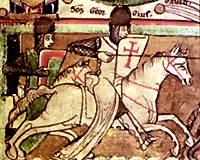
Crusader Knight
The Knights Templar were a secretive brotherhood born out of the Crusading Movement. By AD 1118 the group had coalesced in Jerusalem, and established links with the Holy Sepulchre and its monastic custodians. Jerusalem's third Crusader ruler, King Baldwin II, granted these knights new quarters in the Al-Aqsa Mosque, which had hitherto served as his own palace. As this building occupied part of Temple Mount, the site of Solomon's Temple, the brothers became known (in full) as the Poor Knights of Christ and the Temple of Solomon.
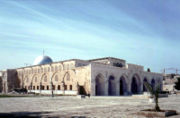
The Al Aqsa Mosque today
Setting themselves apart from other knights and nobles, the Templars renounced all worldly comforts and took severe monastic vows. They undertook to live communally as warrior-monks, pledging their swords to the defense of the pilgrims who hazarded the journey to the sacred places. The task of the first Templars was to drive away the bandits and marauders of the roads. They were also committed to fighting the 'infidel' and generally to defend the Holy Land. The Templars, in due course, were endorsed by the sainted Abbot Bernard of Clairvaux, the charismatic leader of the Cistercian Order, who was among the most influential figures in the West. Bernard's support soon resulted in the brotherhood's incorporation at the heart of the Church. They were officially constituted at the Council of Troyes in 1128, when their Rule was ratified, regulating the brothers' way of life and setting out their duties. It was an extraordinary moment- the establishment of an organ of the Catholic Church committed to violence and bloodshed. The Count of Champagne, meanwhile gave the Order of the Temple an aristocratic seal of approval by joining it- swearing allegiance in the process to the first Grand Master, Hugues de Payens, who had embarked for the East as the Count's own vassal.
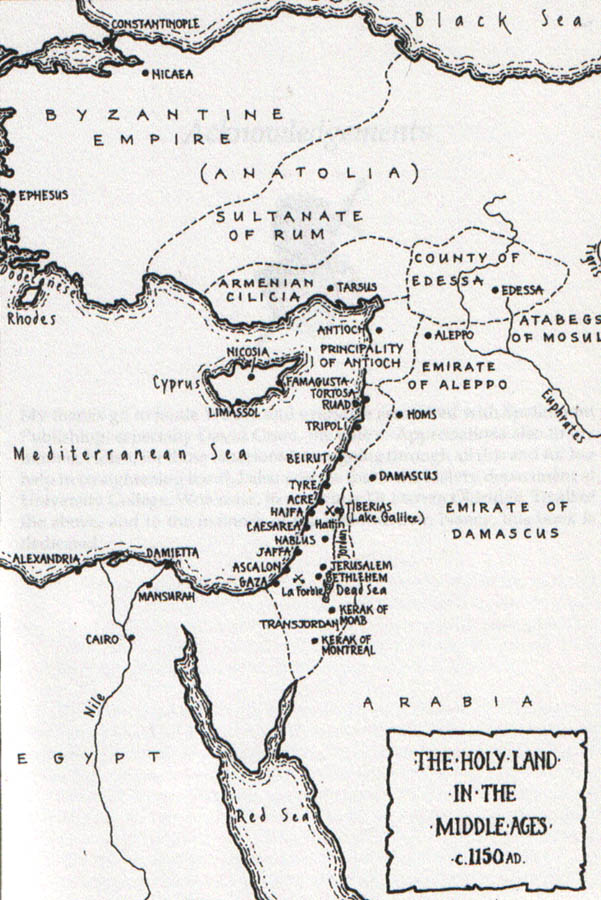
Map, from 'The Rise and Fall of the Knights Templar', Gordon Napier
The knights of the First Crusade had previously recaptured the Holy Land
for Christendom, from the Seljuk Turks and the Fatimids of Egypt. They
created a Latin Christian enclave consisting of the territories of Edessa,
Antioch, Tripoli and Jerusalem. Ringed by enemies, however, the Latin
States remained in peril. In that age of faith, Jerusalem was of significance
to all Christians. Europe's aristocracy made generous donations of land
and wealth to the Templars, believing that this would aid Jerusalem's
defence and their own spiritual salvation. Pious nobles also flocked to
join, meanwhile. Soon the Templars evolved into a formidable army of knights
in white- the vanguard of a virtually ongoing Crusade. They gained ecclesiastical
privilege enabling them to establish effective independence from any earthly
authority besides the pope himself. They also gained the right to have
their own priests, build their own churches (often round in plan) and
bury their own dead.
Many secular lords also became associates of the Templars. One such was Fulk, Count of Anjou. The Templars had a part in negotiating the marriage between Fulk and Melisende, the eldest daughter of Baldwin II, which resulted in Fulk's succession in Jerusalem (though Melisende insisted on her co-sovereignty. At this time the kingdom was menaced by Zenghi the vicious ruler of Aleppo. The Templars supported Fulk in his campaigns against Zenghi's forces. They also supported an unlikely alliance between Christian Jerusalem and Muslim Damascus, against the common enemy. During this time another face of the Templars was revealed by the Arab diplomat Usama ibn Munqudh. Usama went so far as to call the Templars his friends. He described how they defended him from an uncouth Frank when he visited Temple Mount to pray in the small mosque which the Templars had set aside of him. (Later Usama switched sides from Damascus to Aleppo and supported Zenghi's campaigns against the Franks, so his friendship with the Templars obviously had its limitations).
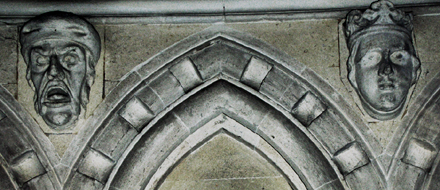
Carved heads in Temple Church, London, formerly within the Templars' British HQ.
The Templars had started to be be granted great castles to aid the defence of the Latin East, and later began to build their own. Some of the first, such as Baghras, were situated in the Principality of Antioch, in the Amanus Mountains. In these early days the Templars were seen as heroic saviours by the Armenian inhabitants of the region, who had hitherto been subject to Seljuk raids from Aleppo. The Order was never established in the County of Edessa, though, to the east . Zenghi took Edessa by storm at Christmas 1144- the first major loss for the Crusaders.
The Templars came of age as a fighting force during the ill-fated Second Crusade (1147-9), helping to hold together the army of Louis VII of France during a difficult crossing of Asia Minor, and lending money to the king when he encountered financial difficulties. They also became a bulwark of the Iberian Reconquista, especially in Aragon and Portugal where they also gained numerous castles and widespread estates. It happened, indeed, that one of the Second Crusades's few successes was achieved not in the east but in Portugal, where the Crusaders, en-route, assisted in the capture of Lizbon from the Muslim Moors.
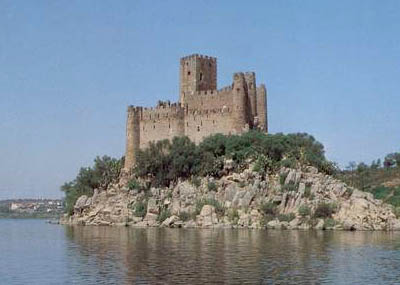
Almoural, Templar Castle in Portugal.
The Kingdom of Jerusalem survived despite the failure of the Second Crusade, which disintegrated after an abortive siege of Damascus. The decision to attack Damascus instead of Aleppo was controversial from the start as Damascus had hitherto been a valued ally for the Franks against Aleppo (now under Zenghi's son Nur ed-Din). The Second Crusade's tactic was not only treacherous but counter-productive. Within the decade Damascus was added to Nur ed-Din's domain. Nur Ed-Din united Syria under his rule, and behind the banner of Jihad- the Islamic holy war against the Franks in the Holy Land. Nur Ed-Din would launch sustained assaults on the Principality of Antioch and the County of Tripoli, and prove a formidable opponent for the Templars. His campaigns in the north took him as far as the coast where he swam in the Mediterranean to show his mastery of the region.
The Templars, while continuing as a military force, became powerful courtiers in the Crusader States- too powerful in the opinion of the hostile chronicler William, Archbishop of Tyre. They fought valiantly if recklessly at King Baldwin III's capture of Ascalon, the last Levantine port in Muslim hands, which had previously been a dangerous thorn in the kingdom's other side. The Templars had previously been granted the lordship of Gaza as a counter to the peril of Ascalon. Control of this region was essential for the Christians, as it hindered the joining up of the two Islamic blocks of Egypt and Syria.
Baldwin III was succeeded by his brother Amalric, with whom the Templars' relations were more strained. Amalric launched a series of misguided military interventions into Egypt. The Templars under the Grand Master Bertrand de Blanquefort refused to take part in the last of these, in 1168, and their rivals the Hopsitallers stepped into the vacuum. The King's campaigns were not successes. Nur Ed-Din managed to send armies to Egypt. One of his officers would eventually seize power in that country, then return to take control of Syria too. That man was Saladin, the Crusaders' nemesis.
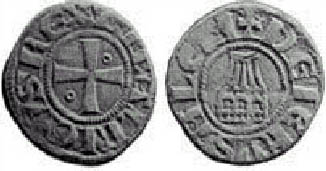
Coins of Amalric I of Jerusalem
Things worsened between the King and the Templars in 1173, meanwhile, when a party of Templars ambushed and slew an envoy of the sinister Nisari Ismaili sect, returning from a conference with the king. Amalric had somehow envisaged the murderous brotherhood better known as the Assassins, as potential allies. The Assassins, radical Shiite Muslims, were best known for killing prominent Sunni leaders, but their secret agents had claimed the lives of Christian barons too, within the Crusader States, and would again. Perhaps the Templars sought to preempt betrayal by the Assassins- professional back-stabbers, whose credentials as faithful allies were certainly lacking. At any rate the Templars' new Grand Master, Odo de St Amand, protected the knight accused of the killing, Walter de Mesnil, and asserted that only the Pope could judge a Templar.
Despite their clash with Amalric, the Templars remained influential figures in the Kingdom of Jerusalem, and were integral to its military defence. Amalric was succeeded by his son, Baldwin IV, the gallant young leper-king. The Templars under Odo helped Baldwin to defeat a vastly superior force invading from Egypt under the Sultan Saladin, at Montguisard. The winning streak was not to last, however, for Saladin returned, this time from Syria, to take and destroy Baldwin's new castle at Jacob's Ford, and to slaughter its Templar defenders. At around this time Odo was captured in battle and afterwards died in a Saracen dungeon. William of Tyre recorded the event unsympathetically.
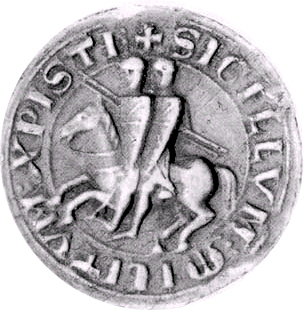
The two-riders seal of the Templar 'soldiers of Christ'
King Baldwin's leprosy was fatal for the kingdom. He was eventually succeeded by his sister Sibylla and her husband Guy de Lusignan. Guy rapidly fell under the influence of the bellicose warlord Reynald de Chatillon, whose may have become unhinged during long years in enemy captivity, and of Gerard de Ridefort, another hot-head who had managed to become Grand Master of the Knights Templar. These two persuaded Guy to to take the offensive and engage Saladin's army, which was again invading the realm. This flew in the face of more captious advice from Count Raymond III of Tripoli with whom Gerard had earlier quarreled. The tactic entailed a forced march across blistering desert. Saladin lured the parched Christians to the shores of lake Galilee (which he cut off from them) and then into battle in unfavourable terrain, on the slope of hill called Hattin, where, on 4 July 1187, the Muslims won a crushing victory. The Christians were particularly demoralize by the loss of the 'True Cross' for they had taken the relic with them into battle before and it had always seemed to bring victory against the odds. After Hattin, though Saladin spared the captured King of Jerusalem, he executed Reynald, and then massacred all the Templars and Hospitallers among his prisoners except for Gerard. So many Christian knights were killed or captured, that day, that there were few to defend Jerusalem, and its fall was inevitable. Many other castles and cities fell, too, emptied of defenders.
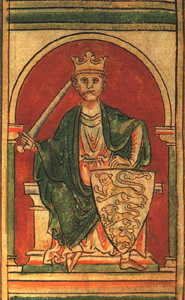
Richard I of England
Europe had not lost its crusading enthusiasm, however. The Third Crusades restored portions of the Latin Kingdom, while plenty came to replace the fallen Templars, who were considered martyrs in a Holy cause. Templars played a key role in King Richard the Lionheart of England's victories over Saladin at the siege of Acre and the spectacular battle of Arsuf. When Richard's army was on the move, the Templars and Hospitallers defended the vanguard and the rear, sustaining and fighting off some of the fiercest attacks from the Turks.
For all its promise, however, the Crusade faltered due to internal divisions. Richard was ultimately advised to turn back from Jerusalem by the Templars and Hospitallers and the local barons who feared that even if it fell, then they would not have too few men to hold on to it. Division also cased problems for the Crusaders. Previously the Marquis Conrad of Montferrat had arrived in the east in time to prevent Saladin's capture of Tyre. Conrad claimed the throne of Jerusalem, seeking to oust Guy, who had meanwhile been freed and become Richard's ally. Conrad and the Duke of Burgundy (leading the French forces remaining after the premature departure of King Philip of France) offered little help to the English king, then striving to restore Ascalon, and even conspired with Saladin, until Richard accepted Conrad's claim to the royal title. No sooner, though, was Conrad acknowledged titular king of Jerusalem than he fell under Assassins' daggers. The crown, (and the hand of the fair heiress Isabella, whom Contad had snatched from her first husband) was passed to Count Henry of Champagne (who himself later met an untimely death tumbling from a balcony). This time around the Templars kept out of the political rivalries, which so distracted many of the Crusaders from the higher cause. Their marginal contribution was handing back the island of Cyprus to Richard, (who had seized it on his way east and then sold it to the Templars) so that Richard could pass it to Guy as compensation for his lost crown on the mainland.
The Third Crusade ended in truce between the war-weary faction. The undefeated Richard departed homeward, some say disguised as a Templar, leaving Jerusalem still in Muslim hands but open to Christian pilgrims. Fate delivered the king into the hands of Duke Leopold of Austria. Richard became a prisoner of an erstwhile crusading comrade, whom he had offended at Acre by casting the Duke's banner from the walls. This turn of events was not the last bitter irony that would reduce the story of the Crusades to a farce.
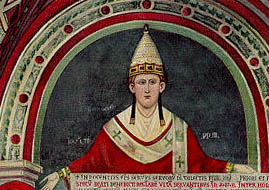
Pope Innocent III, mural, San Speco, Subiaco
Pope Innocent III was keen to foster crusading, and soon initiated the preaching of the Fourth Crusade. The Crusaders ended up in financial debt to the Venetians, and being used by them against Christian enemies first in Dalmatia and then in Byzantium. The expedition dissolved after the brutal sack of Constantinople in 1204, and the near-destruction of the very civilization that the first crusaders had supposedly set out to safeguard from the Muslims. The Templars played little part in the Fourth Crusade and its controversial actions, nor in Innocent III's next crusading project, the 'Albigensian Crusade', against the Cathars of Southern France. The Pope's determination to stamp out the dissenting, neo-Gnostic Christian sect brought about a war waged by northern French barons against their southern counterparts who were accused of sheltering heretics. The main target was the count of Toulouse, Raymond VI, whose ancestor had been a primary leader of the First Crusade. The ensuing persecution of the Cathars led to massacres and mass burnings, and eventually (more significantly for the story of the Templars) to the creation of the original 'thought police', the Inquisition.
Having caused the ravagement of the Languedoc, Innocent III's thoughts turned again to Holy War against Islam. He prepared the way for the Fifth Crusade, but did not live to see it embark. (The titular king of Jerusalem at this time was John of Brienne, an aging, mediocre noble sent to marry Conrad of Montferrat's daughter by the king of France). After skirmishes in the Holy Land, John and the mustered crusaders launched an attack on Egypt. This was intended to strike at the heartland of the Ayyubid dynasty, Saladin's successors in the Middle East. The Templars played a major part in the siege of Damietta on the Nile delta, which surrendered to the Crusaders only after a long and tenacious resistance. The stubborn papal legate, Cardinal Pelagius of Albano, refused to hear talk of compromise, rejecting Ayyubid offers of exchanging Jerusalem for Damietta. Foolishly he led the Crusaders south towards Cairo just as the waters of the Nile rose for the annual flood, cutting off their path. The retreating forces were ambushed and not even Templar discipline could avert disaster. The Crusaders were forced to hand back Damietta in exchange for their lives, and to quit Egypt with no gain.
A few years later the Holy Roman Emperor Frederick II of Hohenstaufen recovered Jerusalem by means of diplomacy with the Sultan of Egypt, al-Kamil. As he entered it, the Latin Church places the Holy City under interdict. Frederick II had come as an excommunicate, and as a result of papal-imperial antagonism, Pope Gregory IX had done his best to sabotage this the Sixth crusade, ordering the Templars not to cooperate with the Emperor. Relations between Frederick II and the Templars became so bad, according to Matthew Paris (English monastic chronicler and grudging admirer of the Emperor), that the Templars attempted to collude with the Muslims to murder Frederick, setting him up for an ambush as he visited the River Jordan. The Sultan was not impressed, and neither was Paris. Neither was Frederick, who would confiscate the Templars' lands in his Italian realm, once he had returned and dealt with the Papal mercenaries who had invaded in his absence- under the command of Frederick's estranged father-in-law John of Brienne.
The feud between the papacy and Frederick would drag on destructively in Europe. Meanwhile thanks to the much-maligned Emperor, Jerusalem lay again fully accessible to Christian pilgrims. Though without unified leadership, the kingdom seemed to be recovering. However the situation was not to last. The Templars under Armand de Perigord seem to have encouraged a switch in policy to ally with Damascus against Egypt. Panicked by the Franks' new alignment, Cairo called on wild mercenaries from the East, the Khoresmians, who took and ravaged Jerusalem in 1244, then joined up with the Egyptians to deliver a crushing blow to the Christians at the battle of La Forbie. It was a disaster on the scale of Hattin. Few Templars escaped and Armand presently died in captivity.
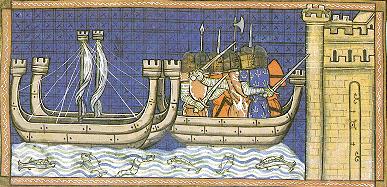
Louis IX and the Seventh Crusaders at Damietta
The last major crusade, the Seventh, eventually got under way under the
flawed leadership of Louis IX of France. It attacked down the Nile, following
the path of the Fifth Crusade. This time Damietta fell quickly, abandoned
by its garrison, and their commander Fakhr Ed-Din in the night (much to
the anger of the ailing sultan as-Silah Ayyub. The resurgent Templars
were in the vanguard as the crusaders again marched south. They swept
all before them after fording the river, and captured the enemy camp,
killing Fakhr Ed-Din However for Louis' brother Robert, Count of Artois
this victory was not enough. He goaded the Templars into accompanying
him in a disastrous charge into the town of Mansourah, without waiting
for the main bulk of the army to catch up. There they were trapped and
slaughtered in the narrow by the Mameluks. The Grand Master, William of
Sonnac, lost an eye in the fighting, escaping only to lose his other and
then his life in battle soon after. The Order's survivors fought bravely
in subsequent engagements, but again the expedition had hit the rocks.
The Muslims cut the crusaders' supply lines, after which hunger, disease
and attrition took their toll. Louis clung on, camped outside Mansourah,
until the hopelessness of the situation became obvious even to him. He
ordered a retreat but his men were all captured, either on land or on
the water, before they could reach Damietta.
The Mamelukes were the bodyguard to the Ayyubid Sultans, circasian slaves trained as elite Muslim soldiers. The Arab chronicler Ibn Wasil termed them 'Islam's Templars', (showing the formidable reputation the Templars had earned among their enemies). These Mameluks initiated a coup, murdering the last Ayyubid Sultan of Egypt, Turan Shah, even as Louis and his companions languished in captivity. Louis was obliged to promise the Mameluks a great ransom for his release, and to apply pressure on Templar financiers for the funds. A participant of the Seventh Crusade, Jean de Joinville almost had to resort to force when boarding the Templars' ship off Damietta for the funds, until his friend the Marshal of the order (soon to become Grand Master) Reynald de Vichiers smoothed things over. Louis kept his side of the deal and quit Damietta, for the Holy Land, but his force was too diminished for him to do much good, and at length he returned to France having wasted much time, money and life. Before long the Mameluks under their sultan Baybars and his successors, swept out of Egypt and, after defeating the Mongols who had also appeared on the scene, began the inexorable annihilation of the vestigial Crusader states in Syria/Palestine.
Meanwhile Europe's Crusading enthusiasm had first imploded and then waned. The Templars were on occasion driven to expressing dismay to the Pope, and to accuse him of hurting the Latin East and the Crusading Ideal by preaching false crusades against political enemies in the West. In 1291, when no western armies came to reinforce them, the Templars in the Holy Land perished defending the last major Crusader city, Acre. The Grand Master William of Beaujeu demonstrated great courage, and died of wounds. The Templars fought on gallantly until the walls tumbled around them. However after Acre's loss the remainder of the Order seemed demoralized, evacuating from Tyre and abandoning their great castle of Atlit without a fight, though it had resisted mighty sieges in the past. They endeavoured to retain a foothold on the island of Arwad off Tortosa, but were obliged to relocate their command base to Cyprus (a Latin state itself since the Third Crusade).
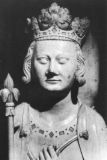
Philip the Fair, tomb figure, Abbey of St Denis
Even after this final failure of the Crusades, the Templars survived throughout Europe as powerful landed elite. They retained their focus on the Holy Land, and their last Grand Master, Jacques de Molay, drew up plans for a new Crusade to regain that territory, having explored the possibility of alliances with the Mongols and Armenians. Before that could happen, though, the king of France, Philip the Fair, accused the Templars of blasphemous crimes. Philip and his ministers, notably William of Nogaret, had all the Templars in France arrested on Friday 13th of October 1307. They initiated a persecution and unleashed against the Templars the horrors of the Inquisition. The King bullied the Pope, Clement V into cooperation. Soon broken-spirited Templars were brought before ecclesiastical courts, to make dreadful confessions. Their testimony ranging from denying Christ and spitting on the cross, to worshipping a monstrous idol (sometimes named as Baphomet), to the giving or receiving of obscene kisses and to sodomy, to carnal rites with demons in female form, and to visions of the devil in the form of a cat. Others doggedly denied any wrongdoing. Eventually, the Pope ordered all the Templars in Europe to be arrested, and urged the royal authorities to use torture against them when similar confessions were not forthcoming. Ultimately, in 1312, the pope declared the Order abolished and banned. Two years later, Jacques de Molay, was brought out to affirm the Order's guilt before the people and dignitaries of Paris. He unexpectedly used the opportunity to utterly repudiate the confession that had been forced from him in previous years. He declared the Order to be wholly innocent. He was supported by his colleague Geofrey de Charney, Preceptor of Normandy. The King was furious and at once ordered both to burnt at the stake. They met their deaths with resigned courage. To the king they were relapsed heretics. There were plenty at the time, though, and there have been plenty since, that have considered them martyrs. Two other high ranking Templar prisoners kept quiet and were led back to their dungeons.
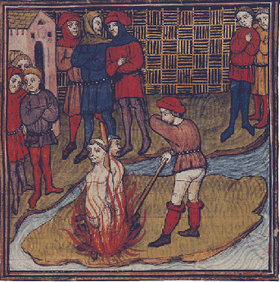
The Burning of the defiant Templar dignitaries Jacques de Molay and Geoffrey de Charney, 1314
Grandes Chroniques de France (14th Century) British Library
The Master of the Temple in England, meanwhile, William de la More, who had always maintained the Order's innocence, died in the Tower of London. The trial of the Templars was a dark period in history, and the only time the inquisitors were reluctantly admitted to ply their trade in England. However in a compromise settlement most of the English brethren were permitted to retire as penitents to scattered monasteries after abjuring all heresy. There were no burnings and little torture was used outside the region controlled by the French regime. Nor were any confessions of heresy, idolatry, apostasy or sodomy forthcoming. In the French realm no Templar died defending his supposed alternative creed. They all die professing their fidelity to the Church; they died for repudiating the lies they had been forced to tell. In the Iberian Peninsula and in Cyprus the Templars maintained their innocence and it was necessary for the authorities to besiege them in their castles before they could be brought to trial. Plenty proved willing to attest to the Order's innocence, and distinguished record of service to the Christian cause.
One of the dark ironies of the Crusades is that the Knights Templar were destroyed not by their Muslim enemy but by the Christian institutions that gave them life. Controversy about the demise of the Templars has raged ever since their dramatic suppression (along with speculation that they protected some great treasure or secret knowledge). The Templars' initiation ceremonies were held in secret, and the Order's habit of secrecy invited suspicion once dark rumours were spread. However as all the confessions heard at the trials were evidently coerced, there seem to be few grounds for believing in the accusations. It is hard to believe and that the Templars might have forced initiates to deny Christ and spit on the cross, even as some sort of test.
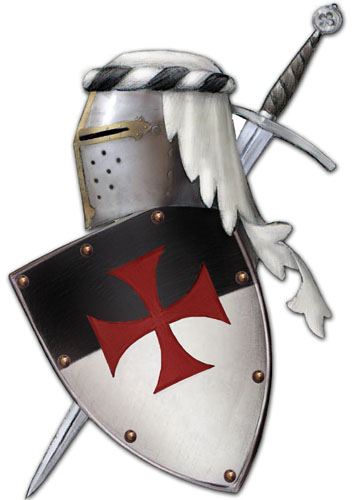
The Arms of the Knights Templar
(Click on image for larger view and details)